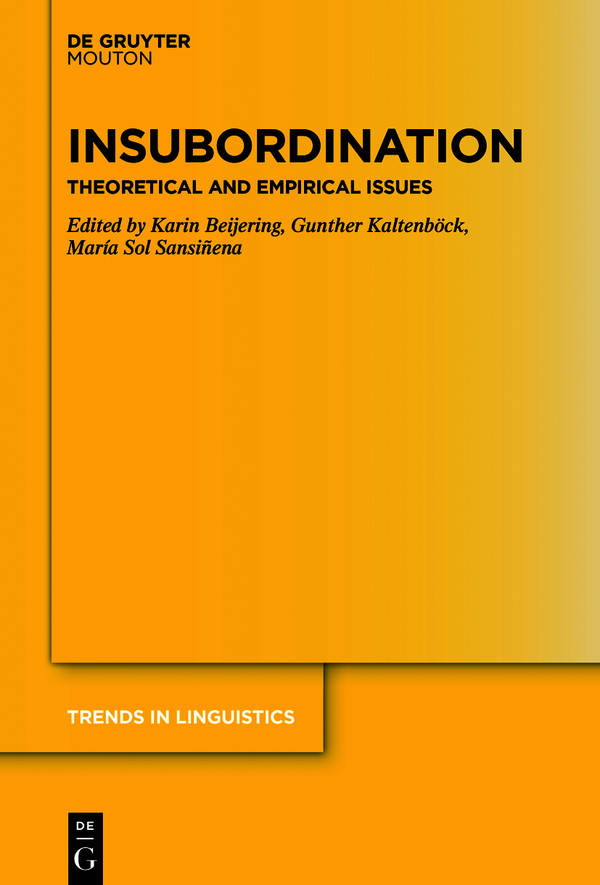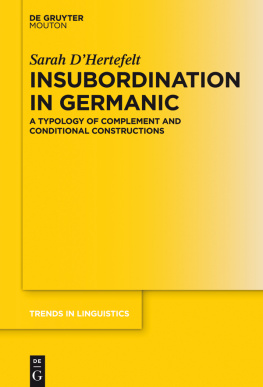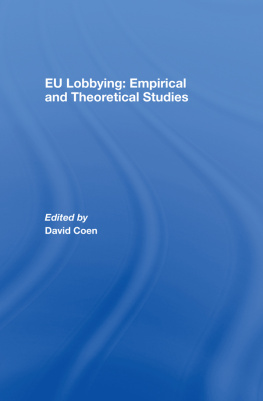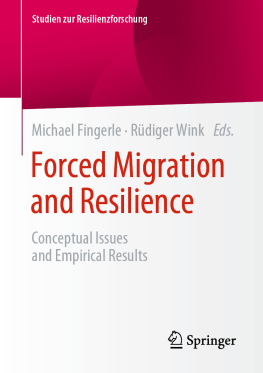Karin Beijering - Insubordination: Theoretical and Empirical Issues
Here you can read online Karin Beijering - Insubordination: Theoretical and Empirical Issues full text of the book (entire story) in english for free. Download pdf and epub, get meaning, cover and reviews about this ebook. year: 2019, publisher: De Gruyter, genre: Science. Description of the work, (preface) as well as reviews are available. Best literature library LitArk.com created for fans of good reading and offers a wide selection of genres:
Romance novel
Science fiction
Adventure
Detective
Science
History
Home and family
Prose
Art
Politics
Computer
Non-fiction
Religion
Business
Children
Humor
Choose a favorite category and find really read worthwhile books. Enjoy immersion in the world of imagination, feel the emotions of the characters or learn something new for yourself, make an fascinating discovery.

- Book:Insubordination: Theoretical and Empirical Issues
- Author:
- Publisher:De Gruyter
- Genre:
- Year:2019
- Rating:3 / 5
- Favourites:Add to favourites
- Your mark:
- 60
- 1
- 2
- 3
- 4
- 5
Insubordination: Theoretical and Empirical Issues: summary, description and annotation
We offer to read an annotation, description, summary or preface (depends on what the author of the book "Insubordination: Theoretical and Empirical Issues" wrote himself). If you haven't found the necessary information about the book — write in the comments, we will try to find it.
Insubordination: Theoretical and Empirical Issues — read online for free the complete book (whole text) full work
Below is the text of the book, divided by pages. System saving the place of the last page read, allows you to conveniently read the book "Insubordination: Theoretical and Empirical Issues" online for free, without having to search again every time where you left off. Put a bookmark, and you can go to the page where you finished reading at any time.
Font size:
Interval:
Bookmark:

Trends in Linguistics Studies and Monographs
Edited by
Volume
ISBN 9783110634129
e-ISBN (PDF) 9783110638288
e-ISBN (EPUB) 9783110634204
Bibliographic information published by the Deutsche Nationalbibliothek
The Deutsche Nationalbibliothek lists this publication in the Deutsche Nationalbibliografie; detailed bibliographic data are available on the Internet at http://dnb.dnb.de.
2019 Walter de Gruyter GmbH, Berlin/Boston
This volume has its origin in a workshop on (Semi-)independent subordinate constructions, held at the Annual Meeting of the Societas Linguistica Europaea (SLE) in Leiden, 2-5 September, 2015. The aim of the workshop was to bring together linguists working on different types of (semi-)independent constructions in a range of languages to deepen our understanding of this somewhat peculiar phenomenon by combining theoretical and empirical perspectives. We are greatly indebted to all the participants of this workshop, both the speakers for their presentations and the members of the audience for the stimulating and constructive discussions.
The written versions of the papers have gone through a selective peer-reviewing process with each chapter having been reviewed anonymously by two to four referees as well as the editors. We would like to thank the contributors for their patience and excellent cooperation in the reviewing process. We are extremely grateful to all the external reviewers for their time and expertise, namely Peter Arkadiev, Dagmar Barth-Weingarten, Giulia Bossaglia, Laurel Brinton, Bert Cornillie, Hendrik De Smet, Mara Estells, Nicholas Evans, Werner Frey, Pedro Gras, Martin Hilpert, Ritva Laury, Beatriz Mato-Mguez, Heiko Narrog, Adeline Patard, Nikolaus Ritt, Daniela Schrder, Elizabeth Traugott, Freek van de Velde, Johan van der Auwera, An Van linden, Anne Wichmann and Camilla Wide.
We also wish to thank Volker Gast and De Gruyter for their support and the opportunity to publish this book in the Trends in Linguistics Series, and to Julie Miess for the editorial assistance. Finally, our particular gratitude goes to Sebastian Haas for his invaluable help with formatting and proof-reading of the manuscript.
Oslo (Norway), Graz (Austria), Leuven (Belgium), November 2018
Karin Beijering, Gunther Kaltenbck, Mara Sol Sansiena
The past decade has witnessed an ever-increasing interest in insubordination and related phenomena, particularly since the appearance of and references therein).
What makes insubordination so intriguing is that it presents a challenge for traditional grammatical frameworks owing to its ambivalent, Janus-like appearance, which combines subordinate structure with main clause function. This dual nature is neatly summarized in Evans definition, which has by now become accepted currency in the field: the conventionalized main clause use of what, on prima facie grounds, appear to be formally subordinate clauses ( Some illustrative examples of insubordination are given in (1) to (4).
ENGLISH (ICE-GB:s1a-089-159)
If you'll just come next door.
SWEDISH ()
| Att | du | aldrig | kan | passa | tider! |
| COMP | you | never | can.PRS | watch.INF | times |
Why cant you ever keep track of the time!
(lit.: That you never can watch the time!)
SPANISH (MABPE2-01b, COLA M)
| Juan (.) que | v-a | a | llov-er |
| VOC COMP | go-PRS.IND.3SG | to | rain-INF |
John, [QUE] its going to rain. (..) []
JAPANESE (: 1)

| Are | wo | mi-te ! |
| that | ACC | look-CNJ |
Look at that!
As can be seen from the examples, insubordinate clauses have all the formal cues of subordinate clauses. These are, for instance, subordinators, infinitive, participal or subjunctive inflections on the verbs, subordinate clause word order, depending on the language-specific markers of subordination. What is absent, however, is a matrix clause. Instead, they are at least in their prototypical forms stand-alone structures as a result of their reanalysis over time as conventionalized independent constructions. Insubordination thus has an inherent diachronic side to it. Insubordinate clauses may look like subordinate clauses but to the extent that they adopt main clause use the term subordinate means, at best, having diachronic origins as a subordinate clause ().
The motivation for subordinate clauses becoming conventionalized as independent structures lies in their adoption of specialized discourse functions. A number of different functions have been identified for insubordinate clauses, for instance the expression of requests, epistemic, evidential and deontic meanings, exclamations, evaluations, and contrastive focus (e.g. ).
work on the North American languages Yupik and Navajo.
As can be seen from the brief overview above, the phenomenon of insubordination has been discussed under various different guises. Other terms used to refer to it include, for instance, independent conditional clause (e.g. : 661691). Although some of these terms may be more accurate, the present volume has adopted Evans insubordination as it has by now become the most established term. It also conveniently highlights the process nature of the phenomenon and captures its unruliness in terms of fitting into traditional grammatical frameworks.
It is precisely this unruliness which makes it fall outside the moulds of traditional grammar that can be seen as responsible for the lack of attention insubordination has received in grammatical descriptions. This is true even for the reference grammars of well-described languages such as Latin, Classical Greek and English (as noted by ).
).
The most comprehensive book-length treatment of insubordination to date is . The contributions span a wide range of different topics from detailed descriptions of (language-specific) structural and semantic correlates of insubordination (e.g. Mithun [Mohawk], Schwenter [Spanish], Gras [Spanish], Lombardi Vallauri [Italian], Narrog [Japanese], Watanabe [Sliammon Salish]) to insights from discourse and interactional linguistic approaches (e.g. Heine et al. [English], Dwyer [Inner Asian Turko-Mongolic languages], Floyd [Chapalaa language of Ecuador]) and typological overviews of insubordination phenomena (e.g. Evans and Watanabe [Kayardild], Verstraete and DHertefelt [Germanic languages], Berge [Aleut], Comrie et al. [Tsezic languages], Robbeets [Transeurasian languages], Cristofaro [cross-linguistic perspective]).
The present volume complements research on the topic. The perspective adopted is a cross-linguistic one which covers a range of different languages (viz. English, Finnish, French, German, Mohawk, Navajo, Old Church Slavonic, Polish, Russian, Spanish, Swedish) and various forms of (semi-)insubordination. By bringing together contributions from different perspectives and theoretical backgrounds, this volume hopes to deepen our understanding not only of individual instances of insubordination, but also of the category as a whole. More specifically, the volume has the following three aims:
Font size:
Interval:
Bookmark:
Similar books «Insubordination: Theoretical and Empirical Issues»
Look at similar books to Insubordination: Theoretical and Empirical Issues. We have selected literature similar in name and meaning in the hope of providing readers with more options to find new, interesting, not yet read works.
Discussion, reviews of the book Insubordination: Theoretical and Empirical Issues and just readers' own opinions. Leave your comments, write what you think about the work, its meaning or the main characters. Specify what exactly you liked and what you didn't like, and why you think so.









